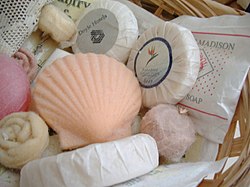Soap
Soap is a chemical compound resulting from the reaction of an alkali (commonly sodium or potassium hydroxide) with a fatty acid. Soaps are the metallic salts of long chain fatty acids. When mixed with water during bathing, cleansing, or washing, they help people and clothes get clean by lowering the chance of dirt and oil to get to the skin or fabric. Soaps are made from animal fats or vegetable oils. There are two basic steps in making soap. They are called Saponification and Salting-out of soap. Some people like to make their own soap.[1]
Soap cleans very well in soft water. It is not toxic to water life. It can be broken down by bacteria. However, it is slightly soluble in water, so it is not often used in washing machines. It does not work well in hard water. It cannot be used in strongly acidic solutions. Mild hand soaps are only basic enough to remove unwanted skin oils. For other forms of oil, dishwashing soap is strong enough to remove almost all forms of oil without damaging petroleum products such as plastics. It does not damage skin either. Soap suds physically capture and lift germs (a virus, bacteria etc.) off of the surface of the skin and then water rinses them into the sink.
Soap has been made in many ways. Humanity has used soap-like things for thousands of years. The earliest recorded evidence of the making of soap-like materials dates back to around 2800 BC in Ancient Babylon[2] and Sumeria.[3] They were soap solutions, or soapy water. People made them by mixing ashes with water and fat and boiling them.[3] The Babylonians used water, alkali and cassia to make soap.[4]
Ancient Gauls added salt to the soap solution to make the solid soap fall out.[3]
The Ebers papyrus (Egypt, 1550 BC) suggests that ancient Egyptians bathed often and had animal and vegetable oils with alkaline salts to make a soap-like substance. Egyptian documents say that a soap-like substance was used in the preparation of wool for weaving.[5]
Soap Media
Two equivalent images of the chemical structure of sodium stearate, a typical ingredient found in bar soaps
Emulsifying action of soap on oil
A collection of decorative bar soaps, as often found in hotels
Structure of a micelle, a cell-like structure formed by the aggregation of soap subunits (such as sodium stearate): The exterior of the micelle is hydrophilic (attracted to water) and the interior is lipophilic (attracted to oils).
Twentieth century packaging of Amigo del Obrero (Worker's Friend) soap, part of the Museo del Objeto del Objeto collection
Caricature of Lillie Langtry, from Punch, Christmas 1890: The soap box on which she sits reflects her endorsements of cosmetics and soaps.
Dudu-Osun – a popular type of African black soap
Azul e branco soap – a bar of blue-white soap
Related pages
References
- ↑ "How to Make Your Own Soap". wikiHow. Retrieved 2018-12-28.
- ↑ Willcox, Michael (2000). "Soap". In Hilda Butler (ed.). Poucher's Perfumes, Cosmetics and Soaps (10th ed.). Dordrecht: Kluwer Academic Publishers. pp. 453. ISBN 9780751404791.
The earliest recorded evidence of the production of soap-like materials dates back to around 2800 BCE in ancient Babylon.
- ↑ 3.0 3.1 3.2 Hugh W. Saltzberg (1991). "Ancient Technology". From Caveman to Chemist. American Chemical Society. pp. 6–7. ISBN 0-8412-1787-4.
- ↑ Alexandra Gerea (January 9, 2016). A soapy affair – The science of homemade soap making. ZME Science. https://www.zmescience.com/other/feature-post/making-soap-home/. Retrieved July 19, 2020.
- ↑ "First Soap - Old Soaps and The First Recorded Evidence of Soap Making". www.soaphistory.net. Retrieved 2022-06-10.









